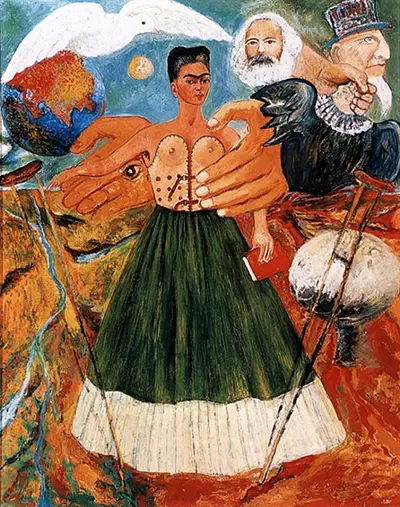The painting itself is a self-portrait that has many elements that demonstrate Frada’s belief that Marxism can heal the sick. The painting comprises of a divided background, one half to represent all that is dark and evil, whilst the other represents the light and good of the world. Frida is shown holding a red book of Marxism, whilst she has been given the ability to stand free of her crutches that she once needed for support. In the painting two large God like open hands are shown curing and trying to free Frida from an orthopaedic leather corset, that is restricting her capacity to breath and move without obstruction.
The God like hands in the picture are symbolising Marxism and the corset is representing oppressive capitalist forces. To further show Frida’s political views the painting consists of symbols of war and peace along with an angelic floating image of Marx, while the US eagle is being strangled. Frida's paintings display fantasy, naivety and a captivation with violence and death, which are strong elements from Mexican folk art. Through her paintings Frida developed a style that mixed reality with surrealism in which she often portrayed suffering and death.
This painting is actually unfished, and it turned out to be one of Frida Kahlo's final paintings. The original title for this painting was, 'Peace on Earth so the Marxist Science may Save the Sick and Those Oppressed by Criminal Yankee Capitalism'. It is said that after creating this painting she found an inner peace in her life that she had never previously possessed, and she is quoted saying, "For the first time, I am not crying anymore." The painting uses oil on Masonite. It is 76x61cm, and it can currently be found in the Frida Kahlo Museum, Mexico City , Mexico.

